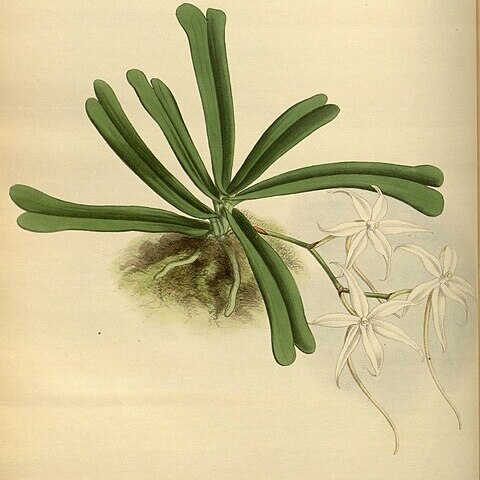Plants epiphytic; with woody stem 10-50 mm long; roots 1-2 mm in diameter; leaves 2-7, dark green, fleshy, up to 150 mm long and 30 mm wide, oblanceolate, apex dilated and unequally bilobed. Inflorescences arising below the leaves, 1-few, mostly pendulous and up to 170 mm long, with 2-6 flowers; bracts triangular, 4-8 mm long. Flowers with spreading perianth lobes, white with pink tinges in the spur. Median sepal acute, lanceolate, 18-25 mm long and 5-7 mm wide; lateral sepals similar but up to 28 mm long. Petals similar, 16-20 mm long and 5-6 mm wide. Lip oblong, apex acuminate, 16-20 x 7-8 mm; spur slender-filiform, pendulous and 60-75 mm long. Gynostemium c. 4 mm long; anther slightly beaked, pollinia globose with rather broad stipes; rostellum with straight beak.
Leaves 2–7, ± forming a fan, lying in one plane, up to 15 × 3 cm, oblanceolate, unequally 2-lobed at the apex with the lobes rounded or acute; lamina dark green or grey-green, usually leathery but occasionally fleshy.
Lip 16–20 × 7–8 mm, oblong, acuminate or apiculate; spur 6–7.5 cm long, pendent, often curving forwards, slightly swollen in apical half but narrowing towards the tip.
Epiphytic herb; stem woody, 1–5 cm long, covered in old overlapping leaf bases; roots numerous, 1–2 mm in diameter.
Flowers set 1.5–3 cm apart, the apical one opening first and larger than the rest, white, usually tinged with pink.
Inflorescences arising below the leaves, to 17 cm long, horizontal or pendent, 2–6-flowered.
Petals spreading or slightly reflexed, 16–20 × 5–6 mm, oblanceolate, acuminate.
Dorsal sepal erect, 18–25 × 5–7 mm, lanceolate, acuminate.
Peduncle to 6 cm long with 1–3 tight sheaths.
Column 4 mm long; anther cap with short beak.
Capsule 4–8 × 0.5 cm, cylindrical.
Pedicel and ovary 18–25 mm long.
Bracts 4–8 mm long.

